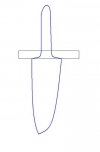Hello,
I allways wonder about the tang construction, I personally LOVE hidden tangs or mortised tangs.
Now some people say (especeally the tactical lovers) that only a full tang will hold up hard use, but history shows us, that stick tangs were common in swords, kukhuris, hirschfänger - and hold up well.
But now a question:
Some people will say, that a stick tang can hold up, when there are no sharp corners (stress raisers), but a lot of Mastersmiths I see here, do square cuts on the ricasso to fit and solder tightly the guard - I think, that the mastersmiths will know what works and what will fail and have absolute faith in them, so where is the secret?
Maybe you can tell me?
regards
surfer
I allways wonder about the tang construction, I personally LOVE hidden tangs or mortised tangs.
Now some people say (especeally the tactical lovers) that only a full tang will hold up hard use, but history shows us, that stick tangs were common in swords, kukhuris, hirschfänger - and hold up well.
But now a question:
Some people will say, that a stick tang can hold up, when there are no sharp corners (stress raisers), but a lot of Mastersmiths I see here, do square cuts on the ricasso to fit and solder tightly the guard - I think, that the mastersmiths will know what works and what will fail and have absolute faith in them, so where is the secret?
Maybe you can tell me?
regards
surfer

